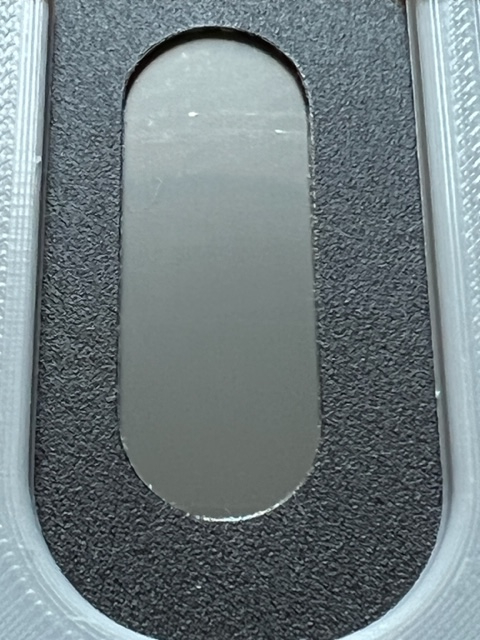Help needed - Fortran 3.13
I'm trying to dump floppies of Fortran 3.13 and I need advice about a disk with the surface that deteriorates.
Surface seems to be visually intact but as soon as I insert the floppy, it make a hissing sound and there is already some damage to the surface.

Note that I've cleaned the floppy reader head before inserting the disk.
What I usually do in this situation is remove the dirt on the surface with qtips and alcohool but strangely in this case there is no dirt (qtips remains white) but instead it looks like it deteriorates the surface.

Any advice ?
Surface seems to be visually intact but as soon as I insert the floppy, it make a hissing sound and there is already some damage to the surface.

Note that I've cleaned the floppy reader head before inserting the disk.
What I usually do in this situation is remove the dirt on the surface with qtips and alcohool but strangely in this case there is no dirt (qtips remains white) but instead it looks like it deteriorates the surface.

Any advice ?
Comments
But man, if the magnetic media is scraped away like what you showed, it’s just not ever going to give you anything.
The surface is not smooth as usual, the q-tip hooks the surface when you pass over it.
The theory is that the binder has turned in to putty. In practice, they don't have to look dirty, they may look perfectly clean. Putting it in to a drive will cause screeching, and the oxide will scrape off on to the drive head. If not stopped quickly, it may rip the oxide completely off of the cookie, leaving a nice transparent area you can see through. And using isopropyl alcohol risks pulling off the oxide layer.
Wabash brand disks were crap, even when they were brand spanking new.
The good news is that the last few I cleaned with my regular washing technique came out perfect with no reading problems or further disintegration. And even the earlier ones that did get scratched were still just readable after a proper cleaning.
Now, two factors are important on wabash disks - heat is important. I still would not recommend using water any hotter than you can touch. But in theory a "baking" technique can also stabilize the binder. Second, you have to keep an eye on the disks while drying the jacket liner can wind up sticking to the cookie and pulling off oxide - so move the q-tips propping up the hub around after an hour or so, to help prevent any kind of sticking.
Anyway, I'll just copy my technique from the last thread about that:
The technique I use is washing/rinsing the cookie with hot water and dawn dish washing soap. Put a few drops of dish soap inside the jacket around the hub, then run a tiny bit of water in around the hub - front left, front right, back left, back right. With just a little bit of water the cookie may turn - if it does, gently brush the surface with a wet clean finger to remove any crud from the cookie surface. If it does not turn don't force it, just continue cleaning it. The next step is to further rinse by running hot (no hotter than you can touch) water in around the hub front left, front right, back left, back right. Since you put dish soap in there, repeat until no suds come out.
Then dry. I usually shake/spin (the entire thing) out the disk out over a bathtub to get some excess water out.
Then take a couple of q-tips and gently insert them in to the jacket around the hub. (I have a photo in another thread of that) https://forum.winworldpc.com/discussion/10511/software-spotlight-archiving-vterm-ii just enough to let some air in on each side.
Let it dry in front of a fan or air purifier or something like that for a perhaps a day. I check it after an hour or so to move the q-tips and make sure the cookie is not sticking to the inside of the jacket.
When it seems dry, make sure the cookie spins easily using your fingers. Don't put it in a drive if the cookie does not spin easily.
Visually inspect the disk cookie to see if there is still any visible crap on it. Clean further if needed.
With Wabash brand disks that might screech, I would "test fit" in a drive that is not installed in to a computer, that you can manually turn the spindle, and that can be easily cleaned. Push the head back to past track 40 and manually try turning the spindle. If you hear screeching or it rips - stop, because it still has crap on it. If it seems to turn ok, move the heads in some and see if it still sounds ok.
If nothing else falls apart, finally try it in a drive.
As there is no mechanical process involved in the procedure (i.e. no contact with the surface, only water, soap and rincing), what is it that stabilizes the surface material ? the heat of the water ?
1: In theory the heat should help temporarily strengthen the binder material. (I'm not a chemist, so I can't say how true this is)
2: It removes sticky or abrasive grime/residue from the disk surface, which is not always visible.
3: It removes similar grime/residue/excess lining adhesive from the jacket lining.
All I really know is that I usually wind up regretting it if I don't clean a suspicious disk first. This is just a procedure that has evolved over the years and has worked well for me. It is time consuming, but it is almost the equivalent of archeology.